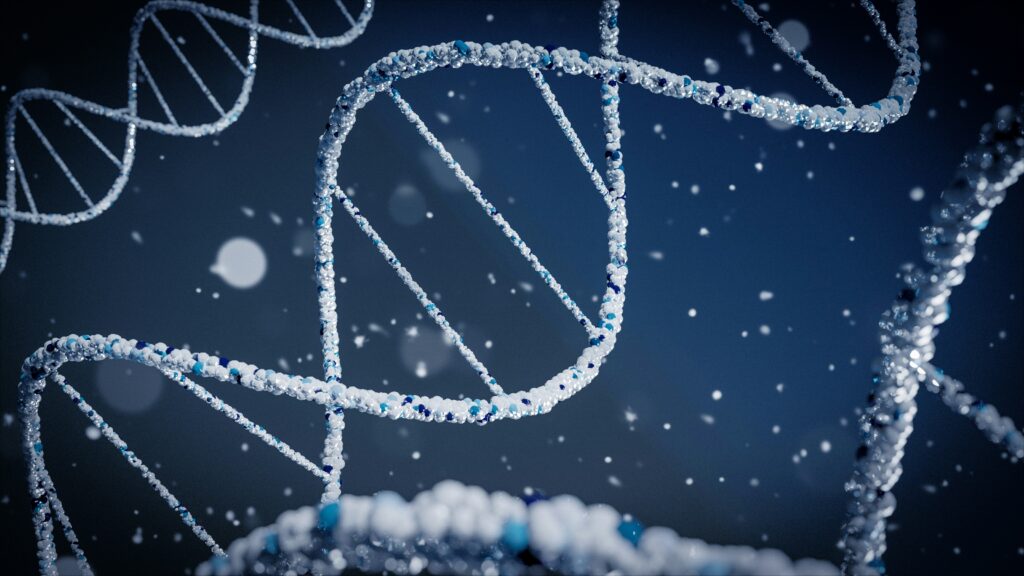DNA, key to genetic identity
Perspectives and Controversies

From biology, we know that what best identifies an individual as belonging to a specific species is its genetic pool, that is, the information contained in its DNA molecules. The genome, the information contained in the DNA of cells, identifies the species to which each organism belongs and individually identifies each member of the species by its two special characteristics: its “individuality”, the property of being unrepeatable between different members of the organism. the species (except in cases of monozygotic twins), and its “continuity” throughout life (except for occasional mutations in some cells of the organism as a whole).
The unrepeatability of the genetic information of each member of the species is a consequence of the mechanisms that generate diversity (fundamentally of mutations and recombination generated through the mechanisms of sexual reproduction). In turn, mutations can be due to changes, losses, or additions of nucleotide bases in the DNA, or other broader ones that affect chromosomal regions or even entire chromosomes. In the end, a genome with more than 3.1 billion nucleotide base pairs in its DNA, such as the human genome, is practically unrepeatable due to its volume and capacity for variation. The diversity among individuals of the species not only affects the part of the genome that is expressed (exons of about 21,000 genes), which constitutes only 2% but also the remaining 98%, which includes the regions of the genes that are not expressed. They are translated into proteins (introns), non-coding regulatory regions, non-coding repetitive and non-repetitive areas, remains of genes that are no longer expressed (pseudogenes), etc.
The best marker of diversity among individuals of the species is the DNA that differentiates them and is conserved from beginning to end throughout the biological cycle in all cells. Of course, mutations can occur, but their frequency is extremely low and their tolerance is subject to the control of very effective molecular repair systems. In man, a mutation in a gene can have a frequency of the order of 1 in 100,000 to 1 in 1,000,000 per generation.
Another thing is the phenotype, such as fingerprints, the color of the iris of the eyes or any other physical trait determined by polygenic systems. They are phenotypes determined by hundreds of genes whose initial manifestation involves environmental factors and local epigenetic phenomena, which act from their formation and can determine expression variations without changes in the DNA information.
What determines the differentiation of cells and morphogenetic changes from the embryonic state to the end of life is the information of the genes and their expression capacity, which can vary within a range more or less limited by epigenetic factors and the influence of the whole genome.
Consequently, after fertilization, if the zygote formed comes from human gametes, we are dealing with a human being and it will develop as such, since the nature of the organism does not change throughout the biological cycle. Regardless of what biology tells us, in the case of human beings, a spiritual component is inextricably linked to bodily materiality, which due to its own indissolubility is inherent to each individual being.
Sticking to the biological aspect, given the strength of the concept of “genetic identity”, associated with the determining role of DNA information, some controversial ideas have emerged that try to minimize its importance. In the book “The Master Builder” (John Murray Press, 2023), by biologist Alfonso Martínez Arias, from the Pompeu Fabra University of Barcelona, it is argued that “it is not our genes that define who we are, but our cells.” That is, it is proposed to give cells the role of determining identity, instead of DNA.
The first thing to point out is that there is a misuse of the word “identity” in this. The RAE dictionary says that identity is the “set of characteristics of an individual or a community that characterizes them compared to others.” From the most basic Biology, if we ascend in the levels of organization that characterize an individual, DNA, cells, tissues, organs, individuals, populations, species… the only one on which the “own traits” that determine the differences depend, is the DNA, genetic information. The differences at all higher levels of organization are due to the expression of the genes they possess, starting with the more than 200 types of cellular specialties that intervene in the supramolecular organization of a mammal. Genetic identity is an inherent and specific property of each individual, from fertilization to death.
A type of debatable statement in the attempt to dethrone DNA from its identifying biological role is to say that “nothing in our DNA explains why the heart is on the left side of the body, how many fingers we have or even how our cells manage to reproduce or that the long lineage of our cells (dating back to the first cell or zygote produced after fertilization) and their intricate interactions within our bodies, make us who we are today.” These statements are not supported by the knowledge accumulated by Developmental Genetics. Genes, not cells, are what provide the information, the blueprints for building the organism with all its components and differential details, of which cells are the most basic. Morphogenesis for the construction of the organism responds to the instructions of the genome, specified in the information sections of the genes (especially the constitutive 2% of the exons of the genes). The materials for the construction of the organism are incorporated following their instructions and are executed in an orderly and regular manner, the first result being cellular differentiation. This depends on the physiological states of activity of the “structural” genes under the direction of the “regulatory genes”. We return to this later.
First, it is worth saying that it does not make sense to say that “an organism is the work of cells. Genes just provide the materials.” It is just the opposite, the organism, with all its cells, tissues and organs, are the final resulting materials of the instructions contained in the genes. For there to be a building, there must first be instructions and an orderly program of action. Cells are materials that are incorporated in an orderly manner according to the information of the genes they contain and that mark the functional differences between them.
We may agree in part with the statement that “the real wonder is how the same genome can build structures as different as an eye and a lung in the same organism,” but that is precisely the result of the existence of a plan, a genetic development program. When a pluripotent cell of the embryo, physically similar to another, some genes are activated and others are silenced, this occurs according to the moment and position that the cell occupies in the whole of the growing embryo. That is why we say, among other reasons, that an embryo is not a mass of cells that are all the same, but rather an organism in full development.
There are genes that send signals to cells in their environment. These signals reach with greater force the closest cells in the embryonic environment, which, depending on the proximity and position, determines changes in the epigenetic state and, therefore, the expression of the cells’ genes, establishing intercellular expression gradients which ultimately determines the differences in their specialization. In this way, a specific route is established in each part of the developing embryo towards the differentiation of tissues and organs, so that at the end of what seemed like a uniform agglomerate of cells, nervous tissue, epithelial tissue, etc. results. and later an eye or a lung.
Despite the functional differences, all the cells of the organism, whether they belong to an eye, a lung, the kidney or any other organ, although they retain the same genetic information formed at the time of fertilization, differ only in the genes that are active in each one of them. Cellular differentiation, that is, cellular specialization, is the product of the differential activity or silencing of genes and not the other way around.
Before we mentioned two types of genes, “regulatory” and “structural” genes. The first are hierarchically the most important, they are those that direct the steps that lead to cellular differentiation, and those that determine where and when during the development that immediately follows fertilization, the “structural genes” must be expressed, to which the functional differences of the cells (proteomic differences) are due. The best paragon to explain this is that of an orchestra that has to develop a symphony. The regulatory genes are equivalent to the director, who directs the different musicians with his baton, represented by structural genes, which intervene in an orderly manner only when the director tells them to do so. This was one of the favorite similes of the French geneticist and doctor Jérôme Lejeune (1926-1994) to explain how the “symphony of life” develops in its early stages.
What Developmental Genetics has taught us is precisely how to carry out a program that is executed in an orderly manner in space and time so that some cells differentiate from others, and according to their position in the embryo, at whose hierarchical peak is the DNA, the genes.
In the book “The Master Builder”, it is argued that the existence of people with two different genomes (chimeras) challenges the idea that it is DNA that defines identity, in favor of cells. However, the probability of survival of embryos from the fusion of two zygotes or two early embryos is an extremely rare phenomenon. Their survival depends on the developmental instructions not being altered. These embryos can be viable as long as there are no interactions between genes or there are no alterations in vital genes incompatible with life. The fact that two genetic identities coexist by accident does not change the hierarchy of DNA as the coordinating center of development and the very infeasibility of most of them demonstrates the need for a balance of genome information to enhance the regular construction of the organism. In this there are no differences with the development of an organism from a zygote resulting from normal fertilization.
From the bioethical perspective, nothing changes regarding the respect due to embryonic life from fertilization, when the genetic identity that constitutes the new being is established. The unicellular zygote is the first bodily reality of a new being.
It is difficult not to relate the attempt to point to cells and not DNA, as determinants of identity, with the intention of lowering the moral status of embryos. It arises when synthetic embryos or pseudo-embryos appear, built by assembling cells from embryos produced by in vitro fertilization, and when the voices of researchers who claim interest in using them in research intensify. This type of attempt is very similar to what happened with the false concept of “pre-embryo”, in order to mask the true nature of human embryos of less than 14 days, and also reminds us of the stage about 25 years ago, when the nature of human embryos from in vitro fertilization was denied in order to be able to use them as a source of stem cells for experimentation, now on the back burner after the appearance of more ethical alternatives.
Related

Vacations and the Popes: A Time to Discover the Word and Nature
Exaudi Staff
05 July, 2025
6 min

How to Live Summer with Faith (with Family and Without Looking Like Martians)
Laetare
04 July, 2025
2 min

Exaudi: Soulful News in Spanish, English, and Italian
Exaudi Staff
04 July, 2025
2 min

When care fails, euthanasia advances: a slippery slope in Spain
Observatorio de Bioética UCV
02 July, 2025
2 min
 (EN)
(EN)
 (ES)
(ES)
 (IT)
(IT)

